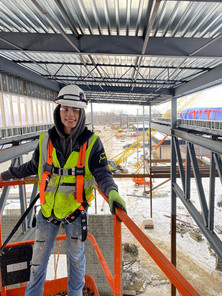EMPLOYERS STRUGGLE TO FILL JOB OPENINGS

https://epaper.daytondailynews.com/popovers/dynamic_article_popover.aspx?guid=12e46d42-8ffa-461b-9773-cda23e6fe2f3&pbid=66ab59ea-5cfc-438d-83e4-dc9e4a34f79d&utm_source=app.pagesuite&utm_medium=app-interaction&utm_campaign=pagesuite-epaper-html5_share-article
Thousands of jobs are available in the Dayton region, despite the ongoing effects of the pandemic recession, but many employers face a familiar problem — finding and keeping skilled workers.
That’s led to an intense focus on training tied to in-demand jobs, providing Sharonda Ivery works on a machine at K&B Molded Products of Clay Twp. The plant uses three shifts to keep up with product demand. The company is having a hard time filling production jobs. everything from basic job-hunting to high-tech skills, a Dayton Dayton Daily News investigation found “It’s all hands on deck to get people trained,” Montgomery County Commissioner Debbie Lieberman said.
Local leaders are optimistic companies will be better able to fill positions as the economy recovers and coronavirus vaccines become increasingly available.
“We know that the economy is going to come roaring back,” said Nick Weldy, superintendent of the Miami Valley Career Technology Center.
“And coming back with a bigger need for a skilled workforce.”
The county is seeing high demand for health-care training, including registered nurses, licensed practical nurses, respiratory therapists and medical billing, coding and administration, said Garth McLean, interim director of workforce development for Montgomery County.
“For dislocated workers we are seeing a lot of interest in transportation and logistics, the trades, like welding, mechanical engineer techs and organizational leadership,” McLean said. “We’ve seen increased volume and interest in our services.”
High demand also exists for commercial truck driver license training. The pandemic forced the closure of the county’s program at the Ohio Business College in Trotwood, but it has reopened with reduced capacity due to pandemic safety protocols.
“The pipeline of new drivers into the industry is significantly less because of the pandemic,” said Bob Costello, chief economist for the American Trucking Associations.“We trained between 30 and 50% fewer drivers in 2020 than we did in 2019.”
The industry lost 45,000 drivers when a new online clearinghouse started last January informing companies when a driver had failed a drug or alcohol test, he said.
Ads for drivers of heavy and tractor-trailer trucks were the most common online job listing in the 12-county JobsOhio West region that includes the Dayton area, according to data compiled from the state’s OhioMeansJobs.com online portal for the 30-day period ending Jan. 13.
“There’s lots of jobs in trucking,” Costello said.
“Pay is absolutely going up.
If you’ve been in the industry for a year, you should be making $55,000 if you want.”
Registered nurses are the second most common online job listing, followed by software developers, retail sales supervisors and retail salespersons.
The state’s website has nearly 25,000 job listings for the area, but some are duplicates and not all companies post ads there, according to the Ohio Department of Job and Family Services.
“There is always a need for nursing staff. There is particularly a need for critical care nurses,” said Sarah Hackenbracht, president and chief executive of the Greater Dayton Area Hospital Association.
“But particularly due to COVID-19, we are seeing a need for emergency room staff, specifically nurses.”
The pandemic curtailed nursing instruction, but students have returned to clinical rotations at most facilities, she said. Hospitals are working with education partners to address impacts the coronavirus restrictions may have had on nursing students, such as additional hands-on training for those who completed some coursework in a virtual environment, Hackenbracht said.
Last year the county had $3.3 million in federal workforce money to train adults and $3.1 million for its Youth- Works training program, Lieberman said. Income-eligible people and those who have lost jobs can get up to $15,000 to pay for training in occupations deemed in-demand under state criteria. That’s more than enough for truck driver school, nearly enough for welding certification and it can offset the cost of nursing training, McLean said.
After Franceska Armstrong, 27, of Dayton was laid off from a factory job in late 2019 she used the county program to go to the Hobart Institute of Welding Technology. In January she was certified in structural welding and recently started a new job at Techmetals Inc. in Dayton.
“I would never have been able to go to Hobart had it not been for this opportunity,” Armstrong said. “I really did try my best to really prevail through all of this and still keep striving for a better future and to be successful.”
County programs will reimburse companies for half the cost of new skills training for existing workers and pay 50% of a new employee’s regular wages for six months of on-the-job training.
“That’s a true incentive for a company to hire somebody that’s been laid off,” Lieberman said.
Officials are readying the new Montgomery County Mobile Workforce Unit, paid for with federal pandemic relief money, to send into neighborhoods to help people with resume writing and job search skills. And this summer the county’s new $2 million Employment Opportunity Center will open at Westown Shopping Center, providing a variety of services, including information technology training and apprenticeships, in partnership with Sinclair Community College.
“People are trying to be extremely creative with training,” said Joanie Krein, vice president-market manager for Manpower in Dayton.
Training programs proliferate
Across the Dayton region, programs exist for companies to train current and prospective employees, retraining for people who’ve lost jobs, internships and apprenticeships for adults, and high school career technology programs.
Local colleges and universities are increasingly bolstering their traditional offerings with training for non-degree, industry-recognized credentials.
“The two-year colleges are the quick reaction team,” said retired Air Force Col. Cassie Barlow, now president of the Southwestern Ohio Council for Higher Education. “But I’m also seeing with our fouryears where they are offering certifications and digital badges and other things along with the degree.”
Interviews with two dozen local and national experts found that one of the biggest challenges — one made more difficult during the pandemic — is getting the word out about training programs, finding job opportunities and picking careers that offer good pay.
“I see all the initiatives that are going on around upskilling and making sure our students are focused on the right majors,” Barlow said. “That’s why I’m so positive about it and so passionate about it.”
Manufacturers’ top concern is finding enough skilled workers, said Angelia Erbaugh, president of the Dayton Region Manufacturers Association. The group is using a state grant to increase the number of people earning credentials, and working with local high schools and colleges to add programs for an industry-recognized production technician certification.
“Industry-recognized credentials ensure that the credential holder has the skills needed to do the job and gives the credential holder a leg up in the hiring and onboarding process,” Erbaugh said. Sinclair Community College programs help companies upskill their current workforce and train students through internships and apprenticeships, said Chad Bridgman, director of work-based learning at the college.
“Think of the apprenticeship program as a kick-starter program getting someone ready to go,” he said. “The willingness and acceptance for blending work and learn is really here.” The state also is pushing for more people to complete the federal Free Application for Federal Student Aid after seeing FAFSA completion decline about 8.9% during the pandemic, said Randy Gardner, chancellor of the Ohio Department of Higher Education.
“Tens of millions of dollars are being left on the table that could be used by someone for technical center enrollment or community college or a university,” Gardner said.
Tech-focused credentials
Ohio bested its goal of awarding funding for 10,000 industry-recognized credentials annually under the new TechCred program, which approved funding for 19,841 technology-focused credentials for in-demand jobs between October 2019 and January, said Ohio Lt. Gov. Jon Husted.
“Technology is changing the type of work that exists, and we have to help people earn the skills that we need,” Husted said. “I believe we are doing as well as any Midwestern state is, but if we can produce more talent, we will attract more employers and we will create more jobs.”
About 150 companies in Butler, Champaign, Clark, Darke, Greene, Miami, Montgomery, Preble and Warren counties were awarded $2.6 million for current and prospective employees to get 2,866 job skill credentials through December, according to the state. Companies get reimbursed for up to $2,000 for each credential earned.
Mile Two, a Dayton systems engineering and software development company that primarily does defense work, received nearly $70,000 in TechCred grants. The company used the grants for highend user experience coursework and innovation leadership training that was too pricey for a small start-up, said Jeff Graley, president of the company that nearly tripled in size to 110 employees last year.
“It’s been a good opportunity for us. We were targeting team building and upskilling,” Graley said. “The world’s moving fast, especially in the innovation space. So learning how to be dynamic and lead teams in a dynamic space is super important.”
The state’s Individual Microcredential Assistance Program offers free techfocused credential coursework for low-income and partially or totally unemployed people.
Ohio Gov. Mike DeWine’s proposed budget includes $70 million to pay for tech-focused credentials, improve workforce efforts in economically distressed rural and urban areas, and collaborate with local partners to expand the state’s skilled workforce.
“We are doing a lot better than we were a few years ago. But I’m not going to suggest that we are doing everything that we need to get done in terms of outcomes,” Husted said. “We have to have people that have the best skills (and have) the most up-todate schools so that employers say, ‘Yes, I can grow here in Ohio. I have the talent.’ ”
Trouble filling jobs
Prior to the pandemic, companies’ No. 1 issue was difficulty finding workers with the right skills. That need remains even after the recession left millions unemployed.
Ohio had 307,000 fewer jobs in January than one year prior, according to the most recent U.S. Bureau of Labor Statistics data. Nationally employment was down 9.5 million year-over-year in February.
“We have a tremendous number of skilled workers who were working a year ago who are no longer working because jobs are not available to them,” said Michael Shields, a researcher at Policy Matters Ohio.
People who come for training are anxious to get back to work, McLean said, but many are afraid they’ll catch COVID-19 in the workplace or bring it home to their families.
A huge factor that experts say has driven women in particular out of the workforce is the need to supervise children due to remote schooling or shuttered child care. Other people leave the workforce after becoming discouraged about finding a job or they retire.
Employers who have a reputation for robust safety protocols have less trouble hiring people, Krein said, and higher pay used to lure workers will linger after the pandemic.
“Wages are going through the ceiling right now. We’re seeing $15 and up just for entry level,” said Doug Barry, owner of BarryStaff of Dayton.
K&B Molded Products in Clay Twp. uses two temp services to fill entry level production jobs that pay $12 per hour. But the company struggles to get workers to stay long enough to be hired full time after 60 days and start getting benefits, said Carl Trimble, vice president of operations. He has to replace five to 10 of his 40 production workers weekly.
Six-day work weeks are mandatory, and hourly pay tops out at $13.50 for a job that mostly involves watching plastic parts drop from manufacturing equipment, Trimble said. Those who move up to more skilled positions earn $14 to $22 an hour.
“There’s plenty of opportunities, but nobody wants to work,” Trimble said. “Today I had four of them who were in here for a month or more, and they were two or three minutes late.”
Some employers say the problem is the $300 extra weekly unemployment compensation people can receive because of federal coronavirus relief, Husted said.
“This could in the end slow our economic recovery,” Husted said. “There has to be a way to protect people who need it, to support people who need it but not create a disincentive for people to go back to work.”
Economists say the enhanced unemployment benefits and direct payments to families kept the nation out of an even worse economic crash last year, because it allowed consumer spending to continue even as 22 million people lost their jobs in March and April.
McLean and Lieberman don’t believe the extra money is enough to stop most people from taking a good job where they feel safe from catching COVID-19.
“That may be true for employers that are paying minimum wage and not paying livable wages,” McLean said. “But for employers paying livable wages, we are seeing jobs being filled.”
Contact this reporter at 937- 610-7417 or email lynn.hulsey@coxinc.com.
Photo - Tanner Hixson, a senior at MVCTC, is an apprenticeship student working with Level MB Construction on the center's expansion. He is from Eaton.









